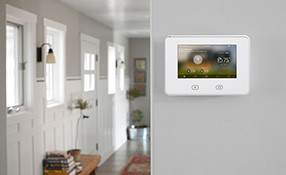 |
| The future will produce cost-effective solutions that can provide meaningful coverage of wide expansive areas |
In accordance with Moore’s Law, our electronics have consistently doubled in speed, halved in size, or halved in price every two years for decades already. This trend means that our electronics, communications networks, data networks, and digital world evolve at a faster pace than anything else in the world, making a huge impact on the security market as well as hundreds of others.
To put the power of the law into perspective, just imagine if Moore’s Law applied to our world beyond electronics and networks. Imagine the year 2025 – just 10 years from today. Imagine flying to China in less than 30 minutes. Imagine driving all the way across Texas on a single gallon of gasoline. Imagine paying just $3 for nearly $100 worth of groceries. What a wonderful world that would be!
Future Technology
But to achieve these outcomes, flight speeds would need to double every two years, fuel efficiency would need to double every two years, and food prices would need to be cut in half every two years. These are aggressive trends to pursue.
Ten more years at those rates, and in 2035 you would be flying to China in less than 60 seconds, driving around the entire planet on a single gallon of gasoline, and paying just about 10 cents for the groceries that cost you $100 today.
But now let’s snap back to reality, because those trends are ridiculous. Nothing can improve that quickly (except our electronics and computer networks).
Security devices have shifted from analog to digital, and are therefore poised to accelerate in their evolution as well. Do we truly realize where this trend can take us and how fast it can take us there? Are we ready to embrace these changes? Does upper management see them coming?
I’m reminded of a scene from the classic comedy The Blues Brothers in which Jake and Elwood (a.k.a. the Blues Brothers) return to Elwood’s apartment. A loud train rolls past the window.
Security devices have shifted from analog to digital, and are therefore poised to accelerate in their evolution as well |
Jake: How often does the train go by?
Elwood: So often that you won't even notice it.
Trains continue to noisily whiz past Elwood’s tiny apartment. The sound of the trains is overbearing at first. However, about one minute later and we – the viewers – have grown accustomed to the sound. Jake apparently does as well, because he falls asleep even as the trains continue to roar past. Perhaps Elwood is onto something…
Personal Experience
Can the greatest trend in history go under-appreciated simply because it is so consistent?
Back in the mid 1990’s, my parents bought a big beige family computer. That beige box was an exciting part of my childhood, and was a large part of why I went on to study electrical engineering. The computer had a whopping 8 GB of storage and cost thousands of dollars.
It is now 20 years later, and I’m walking around with a much more powerful computer in my pocket. My smartphone cost me a small fraction of what my parents paid for that big beige box, it has much better software, it has a much faster internet connection, and I can take it anywhere with ease.
Truly miraculous if you think about it, and even more miraculous if you think about where we might be in another 20 years. While I don’t expect to be flying to China in less than 60 seconds by 2035, I absolutely do expect our computers to be over 1000 times as powerful, 1000 times as small, 1/1000th the cost, or some combination thereof.
Some Bold Predictions
Now that you are hopefully in the proper mindset, here are three bold predictions for the future of surveillance:
- Ultra High Definition: Despite all of the wonderful surveillance technology we have today, surveillance systems are very limited when viewing wide open areas at a long range. Their resolution and analytics don’t come close to the capabilities of the human eye and the human mind, respectively. This will change as digital camera resolutions skyrocket alongside computing power. The future will produce cost-effective solutions that can provide meaningful coverage of wide expansive areas at resolutions hundreds of times greater than modern cameras. Our borders, waterways, parks, streets, and so many other areas will become visible 24x7x365.
- Sensors Everywhere: 8 GB of storage used to fill up a big beige desktop box. Now we can get 128 GB in something the size of a fingernail. Sensors are getting smaller too. Police officers are being outfitted with body cameras, most people carry one with them in their smartphone, and most storefronts have cameras. GoPro is creating a culture of documenting our most interesting moments, or just documenting everything. Meanwhile, electronic sensors are being placed all over our cars, houses, industrial facilities, motors, pumps, ships, and seemingly anywhere and everywhere else. Size reductions may someday enable micro-electromechanical systems (MEMS) to power devices purely from vibrations and temperature gradients. Smaller and more affordable sensors may mean faster refresh cycles in security deployments.
- The Screen: Perhaps you’ve noticed the children at restaurants fixated on their smartphones and tablets. Teenagers often sit in groups at their tables in silence, eyes aimed at their devices. I’ve even gathered with my friends to watch a sports game, only to look up at some point and realize that everyone is staring at their phone screen. Adults walk the streets and hallways buried in their devices. We are so often connected to our screen, checking the latest updates, reading an article, or communicating with someone far away. We work at our computer monitors during the day and then go home to watch TV or read on our tablets, or both. At some point we will collectively spend more time looking at “the screen” that we do looking at the real world around us. What does this mean for security? Simply that the integrated software interface is the centerpiece of a security system’s success. The integrator must work hard behind the scenes to bring a streamlined and unified software interface to their client, because any other solution will obsolete.
Smart phones, smart watches, |
These are just predictions. I do not have a crystal ball, and something even more disruptive may very well come along and derail all of them; but right now these seem to be inevitable trends that will occur over the next 10 to 20 years.
Reshaping The WorldMoore’s Law has reshaped the world, and it will continue to reshape the world. Smart phones, smart watches, smart cars, smart buildings, smart drones, smart everything – all becoming internetworked. Digital currency is taking hold, artificial intelligence is taking off, and data usage rates are skyrocketing. All of this combined has tremendous implications from both a physical security and a cybersecurity standpoint. There will be new creative tools to safeguard the world, and new creative tools to disrupt the world. As security professionals, it is our job to ensure that the client’s business can be conducted safely, reliably, and conveniently.
Technology will continue to accelerate into the future, and this will likely bring about radical socioeconomic changes. There will always be challenges, but we are fortunate to live in these modern times. I encourage us all to take some time to look forward and wonder what is coming up on the horizon. Some will see amazing opportunities. Some may shrug this whole article off and ask, “How often does meaningful innovation really happen?”
My response to those people: So often that you won’t even notice it.
Or will you?






















